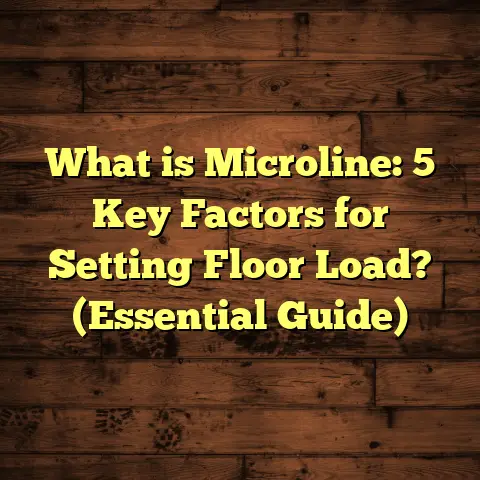What is Extension Space for Flooring? (5 Benefits to Maximize Area)
Comfort has always been my top priority when it comes to the spaces I live in. There’s nothing quite like stepping onto a floor that feels just right beneath your feet—neither too cold nor uneven and with just enough give to make you feel grounded. Over the years, as I’ve worked on flooring projects both in my own home and for clients, one thing became crystal clear: the smallest details often make the biggest difference. One such detail is something called extension space for flooring. At first glance, it might sound technical or even unnecessary, but trust me, it’s a game changer.
If you’ve ever wondered about this term or how it could impact your flooring project, you’re in the right place. I’ll walk you through what extension space really is, why it matters so much, and how you can use it to make your floors last longer, look better, and even maximize your usable space in ways you might not expect.
What Is Extension Space for Flooring?
Think of extension space as a kind of “breathing room” for your floor. It’s a small but essential gap or buffer zone left around the edges of flooring materials during installation. This space allows the materials—whether hardwood, laminate, vinyl, or tile—to expand and contract naturally without causing problems like buckling or cracking.
Floors are not static surfaces; they respond dynamically to changes in temperature, humidity, and even foot traffic. Materials like wood and laminate can expand by up to 3% when moisture levels rise. Without extension space, this growth has nowhere to go except upwards or sideways, which can cause visible damage.
Let me give you an example from my own experience. When I installed hardwood floors in my living room about five years ago, I made sure to leave an extension gap of about ¾ inch around the perimeter. That seemingly tiny gap prevented the boards from pushing against the walls during humid summers. The floor stayed flat and smooth, even after years of seasonal changes. Had I skipped this step, I’d probably be dealing with buckled boards or costly repairs by now.
Why Do Floors Need This Space?
You might ask yourself: “Why can’t flooring materials just be installed tightly against walls or each other?” Well, here’s the thing — wood and other materials are hygroscopic, meaning they absorb moisture from the air. When the humidity rises, wood planks can swell; when it drops, they shrink again.
Without extension space, this natural movement leads to pressure build-up. Imagine trying to squeeze a sponge into a box that’s too small—it will bulge and deform. Floors behave similarly if they don’t have room to flex.
The Science Behind Flooring Movement and Extension Space
Understanding why extension space works requires a peek at how moisture affects different flooring materials:
- Wood: Wood expands across its width by roughly 0.1% for every 1% increase in moisture content. For example, if a 10-foot-wide hardwood floor absorbs moisture during a humid season, it could swell by about 0.12 inches—enough to cause warping if no gaps exist.
- Laminate: This material typically has a fiberboard core that also expands with moisture changes but slightly less than solid wood. Still, installers recommend an expansion gap of at least ¼ inch for every 8 feet of flooring width.
- Vinyl: Luxury vinyl planks expand less than wood but still need some breathing room to prevent buckling and separation.
- Tile: Ceramic or porcelain tiles don’t swell but require movement joints to handle structural shifts in subfloors and temperature changes.
Industry standards recommend leaving between ¼ and ¾ inch of extension space around room perimeters depending on material and room size.
What Happens When Floors Have No Extension Space?
Based on my experience and reports from other flooring professionals:
- Buckling: Floors push upwards creating uneven surfaces that can be dangerous.
- Gapping: Planks pull apart leaving visible cracks.
- Cracking: Tiles or hardwood boards may break under stress.
- Squeaking: Tight floors rub against joists causing annoying noises.
- Premature wear: Stressed floors degrade faster requiring expensive fixes.
A National Wood Flooring Association (NWFA) study found that missing or inadequate expansion gaps cause nearly 70% of hardwood floor failures reported within five years.
The 5 Benefits of Using Extension Space to Maximize Area
So far, we’ve talked about why extension space is important to prevent damage. But here’s something many people miss: strategically using extension space can actually help you maximize your usable floor area creatively and comfortably.
Let me share the five key benefits I’ve seen through my hands-on work and research:
1. Protects Your Flooring Investment — Saving You Money
Floors aren’t cheap, especially hardwood or quality laminate. Extension space protects your investment by preventing costly damage due to natural material movement.
I once worked on a project where a client had bought premium oak flooring but wanted everything installed flush to the walls for a “clean look.” Within months, their floor buckled badly during summer humidity spikes. Repairs cost them thousands — avoidable with proper extension gaps.
According to industry data:
- Hardwood floors with correct expansion space have a failure rate under 10%.
- Those without proper gaps face up to 70% failure within five years.
Extension space is literally insurance for your flooring.
2. Increases Longevity with Less Maintenance
Floors under constant stress wear out faster. Materials too tightly packed crack or separate over time needing continual repairs.
In one residential complex I helped renovate, units with proper expansion gaps had floors lasting well beyond 10 years with minimal upkeep. Units without them faced squeaks, loose boards, and visible damage within two years.
This means less time worrying about repairs and more time enjoying your beautiful floors.
3. Enhances Comfort and Safety
A stable floor isn’t just about looks; it’s about how it feels underfoot.
Floors with extension space stay flat and quiet. I’ve noticed that families living on floors without gaps complain about creaks and unevenness that can become tripping hazards.
When you walk barefoot or place furniture down gently, a floor with room to flex feels smoother and more solid—something I personally appreciate after years of working in different homes.
4. Allows for Future Adjustments or Repairs Without Hassle
Here’s a practical tip from my experience: extension spaces make repairs easier.
When water damage happened in a client’s kitchen last year, we were able to slide out damaged planks from the edge thanks to the existing gap instead of ripping up large sections.
This saved time, effort, and money on demolition and reinstallation—a win-win for everyone involved.
5. Maximizes Usable Floor Area Creatively
You might think extension space wastes floor area since it’s technically “empty,” but when planned smartly it actually maximizes your usable space.
How? By placing gaps strategically near doorways, closets, or transitions between rooms, you avoid awkward cuts or mismatches that eat into usable flooring later.
For example, in an older home renovation I did recently, we extended laminate floors seamlessly into adjoining rooms using planned extension spaces at thresholds. The floors looked continuous and spacious without odd edges or wasted material.
How Much Extension Space Should You Leave?
Determining the right gap size depends on several factors:
- Flooring type
- Room size
- Climate/humidity conditions
- Subfloor type
Here are some general guidelines based on manufacturer recommendations and my own projects:
| Flooring Type | Recommended Gap Size |
|---|---|
| Hardwood | 3/8 inch to ¾ inch |
| Laminate | ¼ inch to ½ inch |
| Vinyl Plank | ¼ inch |
| Tile (movement joints) | 1/8 inch per 10 feet (varies) |
For large rooms over 20 feet wide, you might need wider gaps or additional expansion joints in the middle of the floor as well.
Honestly, when in doubt I prefer a slightly larger gap covered by trim rather than risking too small a gap. It gives me peace of mind knowing the floor has room to adjust.
Stories From My Flooring Projects Involving Extension Space
I want to share some stories from my work because real-life examples bring these ideas home better than theory alone.
Story #1: The Humid Basement Disaster
A client called me frantic after their basement laminate started buckling badly six months after installation. They had no extension gap at all—the installer just pushed planks tight against walls.
We removed several rows along one wall and left a proper ½ inch gap before reinstalling baseboards. Problem solved! The floor expanded naturally during humid months without damage afterward.
This experience taught me how critical extension space is for below-grade rooms where moisture fluctuates wildly.
Story #2: Creative Use of Extension Space in Narrow Hallways
In an older townhouse renovation I did last year, narrow hallways made flooring tricky because walls weren’t perfectly straight.
By leaving calculated extension spaces along hall edges hidden behind baseboards, we avoided forcing planks into tight spots that would eventually warp or crack.
The final result was smooth floors that looked custom-made—something impossible without respecting extension space needs.
Story #3: Using FloorTally for Precise Planning
I used FloorTally extensively when planning a mid-sized condo flooring job last year. Inputting exact room dimensions plus planned extension spaces helped me accurately estimate materials including waste factors—no surprises mid-project!
Having those precise numbers upfront also helped explain costs clearly to clients who appreciated transparency about why certain buffers were necessary.
Tips for Measuring and Planning Your Extension Space
If you’re considering a DIY flooring project or want to better understand what your contractor is doing, here are some practical tips I follow:
- Measure Room Dimensions Accurately: Use a laser measure if possible for precision.
- Check Manufacturer Guidelines: Every flooring brand lists recommended expansion gaps.
- Plan for Waste: Add roughly 5-10% extra material for cutting mistakes plus extension spaces.
- Leave Gaps Around Fixed Objects: Door frames, cabinets, stairs need space too.
- Cover Gaps with Trim: Use baseboards or quarter-round moldings so gaps aren’t visible but still functional.
- Consider Climate: In very humid regions larger gaps might be needed.
- Don’t Skimp on Gap Size: Better slightly bigger than too small.
- Ask About Transition Strips: These can help manage expansion between different flooring types or rooms.
How Using Extension Space Made Me More Efficient And Saved Money
I want to be honest—at first I underestimated the importance of extension space when I started installing floors myself years ago. I thought tight-fitting floors looked cleaner and neater until I saw what happened when materials expanded with no room left.
Once I started leaving proper extension spaces consistently:
- My repair calls dropped drastically.
- Client satisfaction increased because floors lasted longer.
- Installation became smoother since I didn’t have to force planks into tight spots.
- Budget estimates became more accurate thanks to factoring buffer zones into material calculations using tools like FloorTally.
FloorTally especially has been invaluable because it automates calculations including waste percentages and labor based on local rates—helping me plan budgets realistically instead of guessing.
What If You Already Have Flooring Without Extension Space?
- Buckling or warping
- Gapping between planks
- Cracks in tiles
- Squeaking noises
- Uneven surfaces
If you notice these issues early enough:
- Removing baseboards carefully might let you add some gap by sanding edges.
- Installing flexible transition strips may relieve some pressure.
- In worst cases, partial reinstallation might be necessary.
I’ve helped clients fix tight floors by carefully removing edges and creating small gaps covered with trim—usually saving them from complete replacement.
Final Thoughts on Extension Space for Flooring
Extension space may seem like a small detail in your flooring project but its impact is huge—from protecting your investment to improving comfort and even creatively maximizing usable area.
Through decades of hands-on experience and backed by data from industry experts like NWFA, I can say confidently: leaving room for your floor to breathe is non-negotiable if you want beautiful, long-lasting results.
If you ever feel unsure about measuring or planning your extension space—or want help estimating costs—I’m here to chat anytime! Remember, good floors start with good planning—and that starts with giving your materials the space they deserve.
Feel free to ask me any questions about specific flooring types or how much extension space you should leave based on your climate or room size! And if you want tips on using tools like FloorTally for budgeting and planning your project efficiently, just let me know—I’m happy to share what’s worked best for me over many years in this business.





